Numerical Study on Wave Dissipation Performance of OWC-Perforated Floating Breakwater under Irregular Waves
Abstract
1. Introduction
2. Calculation Model
2.1. Governing Equations
2.2. Equation of Motion and RAOs
2.3. Mooring System
2.4. Wave Transmission Coefficients
2.5. Irregular Sea States and Repetitions
2.6. Meshing Method
3. Validation of the Numerical Model 3
3.1. Simulation of Irregular Waves
3.2. Validations for the RAO of Double Box Floating Breakwater
3.3. Validations for the Kt of the Mooring Floating Breakwater
3.4. Validations of the Porous Floating Breakwater
3.5. Validations of the OWC Breakwater
4. Results and Discussion
4.1. Numerical Simulation Conditions
4.2. Structure Comparison
4.3. Influence of Spacing
4.4. Influence of Water Depth
4.5. Influence of Incident Wave Angle
4.6. Significant Wave Height
5. Conclusions
- (1)
- The wave dissipation effect of the OWC-perforated floating breakwater is superior to that of similar structures.
- (2)
- The spacing between the floating breakwater components has a significant impact on the transmission coefficient, particularly for long-period waves. The width of the OWC opening influences the wave dissipation effect. A wider opening is more effective for long-period waves.
- (3)
- The water depth has a great influence on the wave dissipation performance of OWC-perforated floating breakwater. A shallower water depth yields better wave dissipation. The significant wave height has little effect on the wave dissipation effect. The wave dissipation performance is better when the incident wave angle is 0°.
- (1)
- This paper only discusses the wave dissipation performance of the OWC-opening double-body floating breakwater. Further research is needed on factors such as anchor chain force and wave pressure, and the coupling effect between the mooring system and the floating breakwater also needs to be considered.
- (2)
- This paper does not simulate and calculate the conversion efficiency of the embedded OWC wave energy conversion device. The influence of different wave conditions and different OWC opening widths on the wave energy conversion efficiency can be further simulated and discussed.
Author Contributions
Funding
Institutional Review Board Statement
Informed Consent Statement
Data Availability Statement
Conflicts of Interest
References
- Williams, A.N.; Lee, H.S.; Huang, Z. Floating pontoon breakwaters. Ocean Eng. 2000, 27, 221–240. [Google Scholar] [CrossRef]
- Wang, X.W.; Li, J.; Chen, J.Y.; Ji, C.Q.; Zhang, J.F. Wave attenuation performance of double floating box floating breakwater under long-period waves. Port Waterw. Eng. 2021, 8, 8–12. [Google Scholar]
- Zheng, Y.N.; Yao, Y.P.; Dong, G.H.; Chen, C.P. Time-domain numerical simulation of wave action on double-box floating breakwater. In Proceedings of the 15th China Offshore Engineering Symposium, Taiyuan, China, 3–6 August 2011; pp. 162–167. [Google Scholar]
- Wang, Z.Y.; Wang, Y.X.; Wang, G.Y. Numerical study on hydrodynamic characteristics of anchor chain anchored double pontoon floating breakwater. In Proceedings of the 15th China Offshore Engineering Symposium, Taiyuan, China, 3–6 August 2011; pp. 183–189. [Google Scholar]
- Sun, B.; Li, C.; Yang, S.; Zhang, H.; Song, Z. Experimental and numerical study on the wave attenuation performance and dynamic response of kelp-box type floating breakwater. Ocean Eng. 2022, 263, 112374. [Google Scholar] [CrossRef]
- Zhang, H.; Sun, B.; Li, Z.; Wang, F. Wave attenuation and motion response of floating breakwater with sponge material. Ocean Eng. 2023, 277, 114325. [Google Scholar] [CrossRef]
- Xu, X.L.; Li, Y.; Sun, X.L.; Chen, Z.; Zhang, Y.; Kong, F.; Shu, N. Experimental study on wave dissipation characteristics of double row adjustable floating box breakwater. Port Eng. Technol. 2017, 54, 28–33. [Google Scholar]
- Shen, X.S.; Pan, J.N.; Zhou, Y.R.; Wang, X.G. Experimental study on wave dissipation performance of double floating box floating breakwater. Ocean Eng. 2018, 36, 47–54. [Google Scholar]
- Shunichi, I.; Yasuhiro, S. Study On the Performance of a Floating Breakwater with Two Boxes. In Proceedings of the 12th International Offshore and Polar Engineering Conference, Kitakyushu, Japan, 26–31 May 2002. [Google Scholar]
- Wang, H.Y. Experimental Study and Numerical Simulation of Porous Floating Breakwater; Dalian University of Technology: Dalian, China, 2010. [Google Scholar]
- Hu, W.Q.; Yu, W.G.; Zhan, J.M.; Fan, Q.; Gong, Y.J. Study on wave attenuation characteristics of a three-dimensional porous structure. In Proceedings of the 10th National Conference on Fluid Mechanics, Hangzhou, China, 26 October 2018; pp. 185–186. [Google Scholar]
- Liu, D.X.; Zheng, Y.N.; Zhang, J.X. Research and application progress of oscillating water column wave energy power generation device. J. Dalian Ocean. Univ. 2015, 30, 231–236. [Google Scholar]
- Li, X.; Yu, Z.; Qu, H.; Yang, M.; Shi, H.; Zhang, Z. Experimental Study on the Aerodynamic Performance and Wave Energy Capture Efficiency of Square and Curved OWC Wave Energy Conversion Devices. Sustainability 2023, 15, 4963. [Google Scholar] [CrossRef]
- Masoomi, M.; Yousefifard, M.; Mosavi, A. Efficiency Assessment of an Amended Oscillating Water Column Using OpenFOAM. Sustainability 2021, 13, 5633. [Google Scholar] [CrossRef]
- Tsai, C.-P.; Ko, C.-H.; Chen, Y.-C. Investigation on Performance of a Modified Breakwater-Integrated OWC Wave Energy Converter. Sustainability 2018, 10, 643. [Google Scholar] [CrossRef]
- He, F.; Huang, Z.H.; Law, A.W. Hydrodynamic performance of a rectangular floating breakwater with and without pneumatic chambers: An experimental study. Ocean Eng. 2012, 51, 16–27. [Google Scholar] [CrossRef]
- He, F.; Huang, Z.H. Hydrodynamic performance of pile-supported OWC-type structures as break-waters: An experimental study. Ocean Eng. 2014, 88, 618–626. [Google Scholar] [CrossRef]
- Yu, D.Y.; Qu, M.; Xie, Y.J. Scheme design and experimental study of a pile foundation breakwater with integrated OWC air chamber. Acta Energiae Solaris Sin. 2021, 42, 379–386. [Google Scholar]
- Kshma, T.; Santanu, K. Mathematical modeling of breakwater-integrated oscillating water column wave energy converter devices under irregular incident waves. Renew. Energy 2021, 178, 403–419. [Google Scholar]
- Zhang, H.; Zhou, B.; Vogel, C. Hydrodynamic performance of a dual-floater hybrid system combining a floating breakwater and an oscillating-buoy type wave energy converter. Appl. Energy 2020, 259, 114212. [Google Scholar] [CrossRef]
- Zhang, H.; Zhou, B.; Vogel, C. Hydrodynamic performance of a floating breakwater as an oscillating-buoy type wave energy converter. Appl. Energy 2020, 257, 113996. [Google Scholar] [CrossRef]
- Howe, D.; Nader, J.R.; Macfarlane, G. Performance analysis of a floating breakwater integrated with multiple oscillating water column wave energy converters in regular and irregular seas. Appl. Ocean Res. 2020, 99, 102147. [Google Scholar] [CrossRef]
- Lin, P. Numerical Modeling of Water Waves; CRC Press: Boca Raton, FL, USA, 2008. [Google Scholar]
- Jin, J. A Mixed Mode Function-Boundary Element Method for Very Large Floating Structure-Water Interaction Systems Excited by Airplane Landing Impacts. Ph.D. Thesis, University of Southampton, Southampton, UK, October 2007. [Google Scholar]
- Goda, Y. A comparative review on the functional forms of directional wave spectrum. Coastal Engineering Journal 1999, 41, 1–20. [Google Scholar] [CrossRef]
- Wang, T.T.; Liu, Z.Q. Numerical simulation of double floating tank double water flat floating breakwater. Port Waterw. Eng. 2016, 3, 46–50. [Google Scholar]
- Hou, Y. Experimental Study on Hydrodynamic Characteristics of Single Square Box Anchor Chain Floating Breakwater; Dalian University of Technology: Dalian, China, 2008. [Google Scholar]
- Liu, X.M. Experimental Study on Physical Model of Porous Floating Breakwater; Dalian Ocean University: Dalian, China, 2019. [Google Scholar]
- Wang, P. Experimental Study on Hydrodynamic Characteristics of Multifunctional Oscillating Water Column Device with Horizontal Bottom Plate; Zhejiang University: Hangzhou, China, 2019. [Google Scholar]



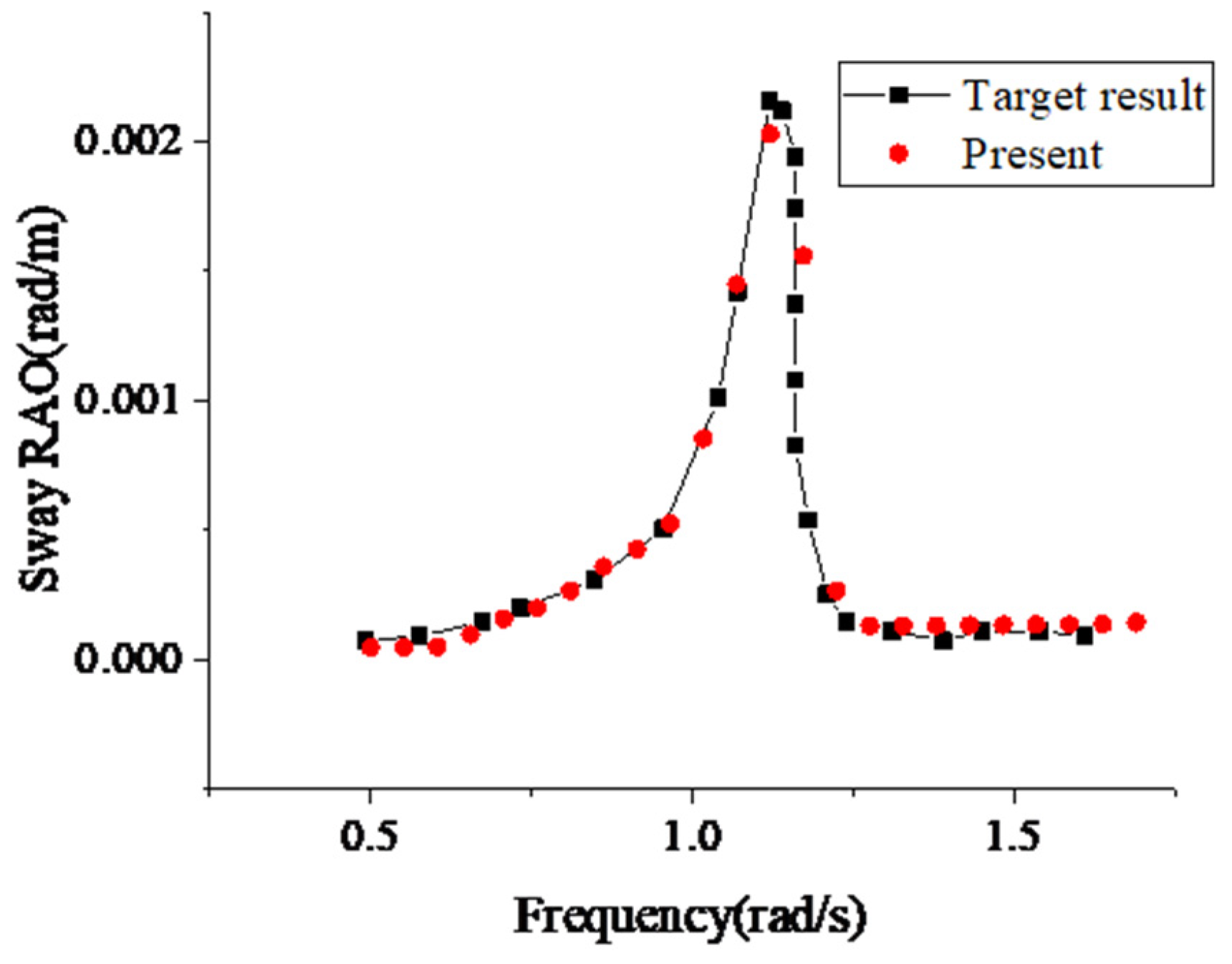
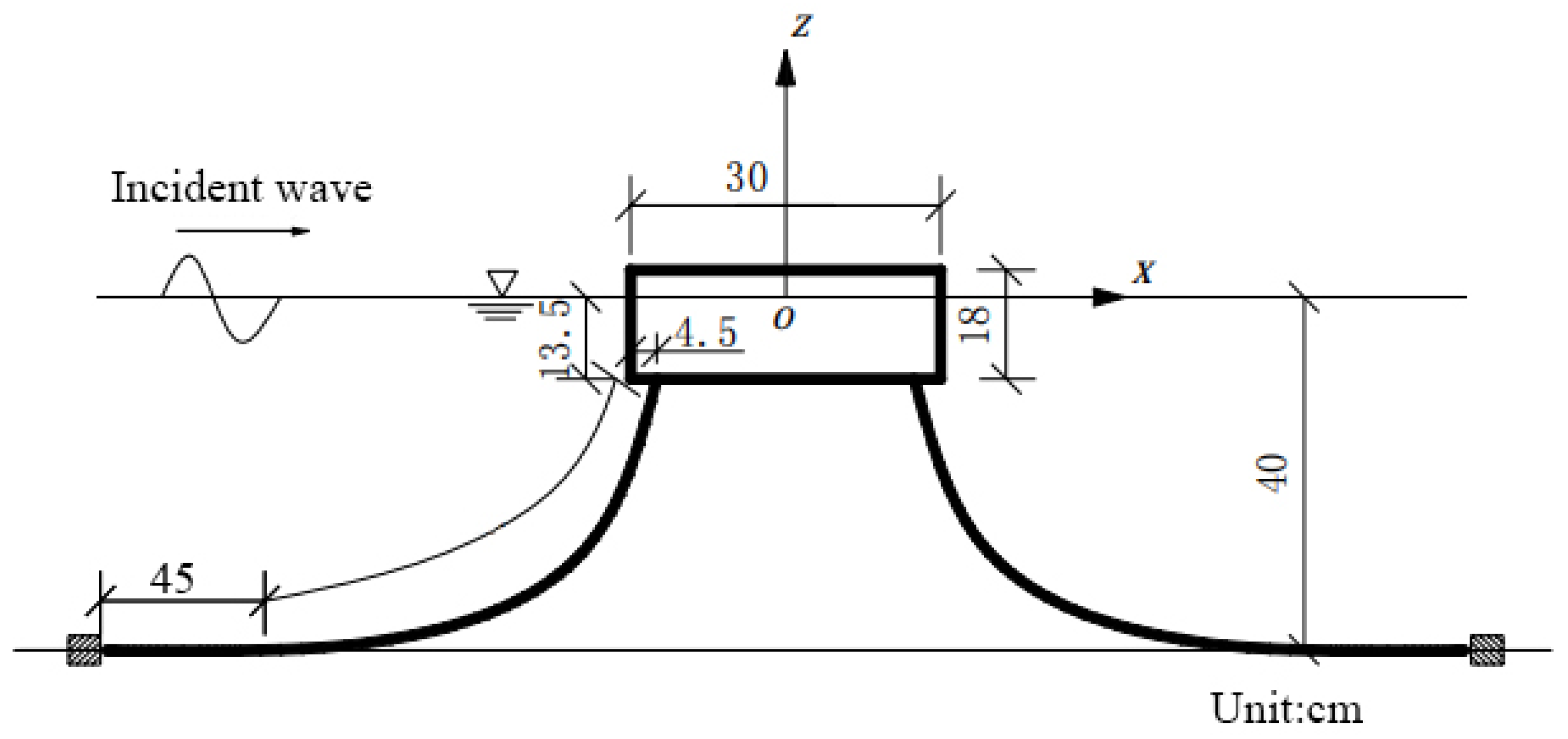

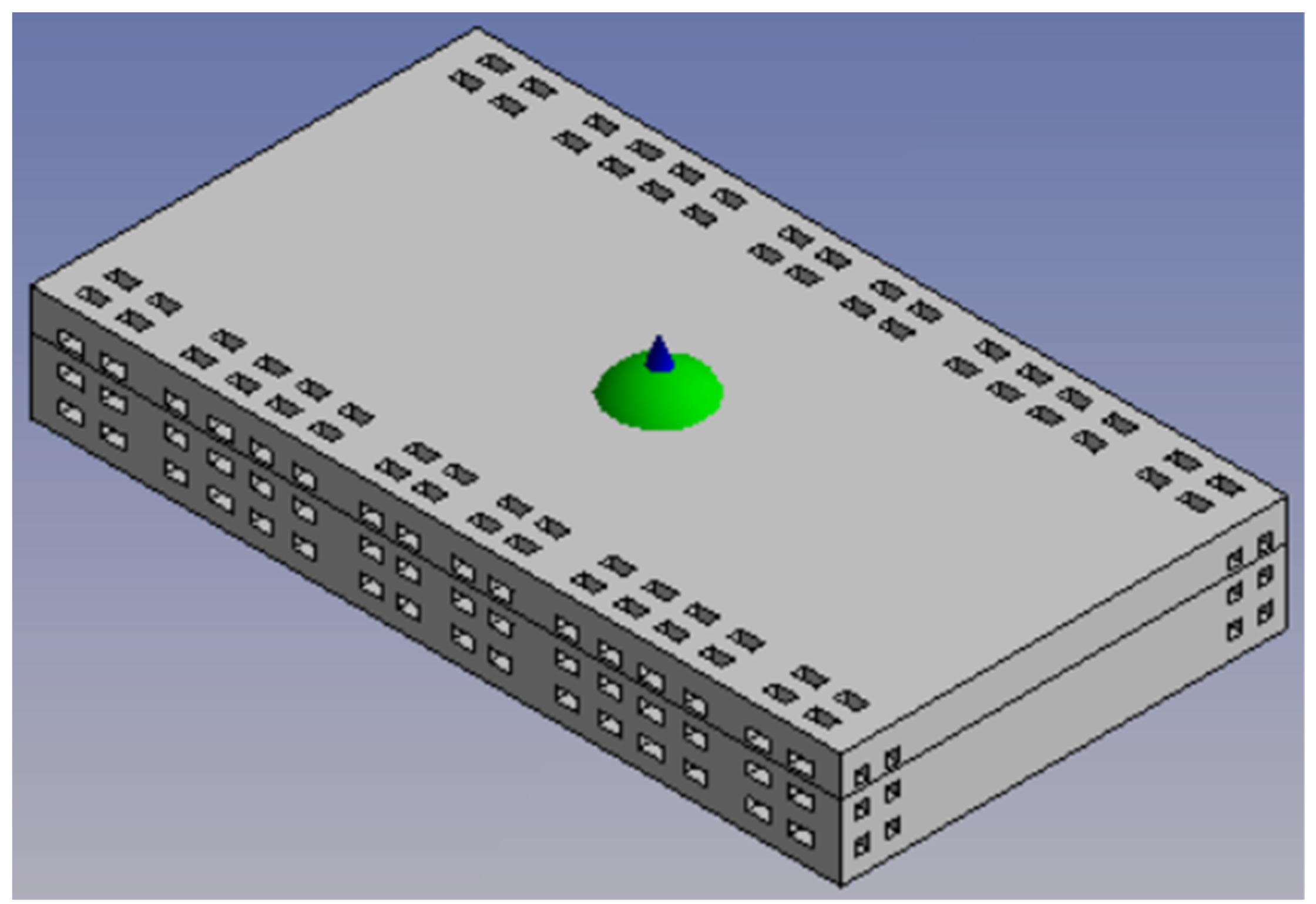
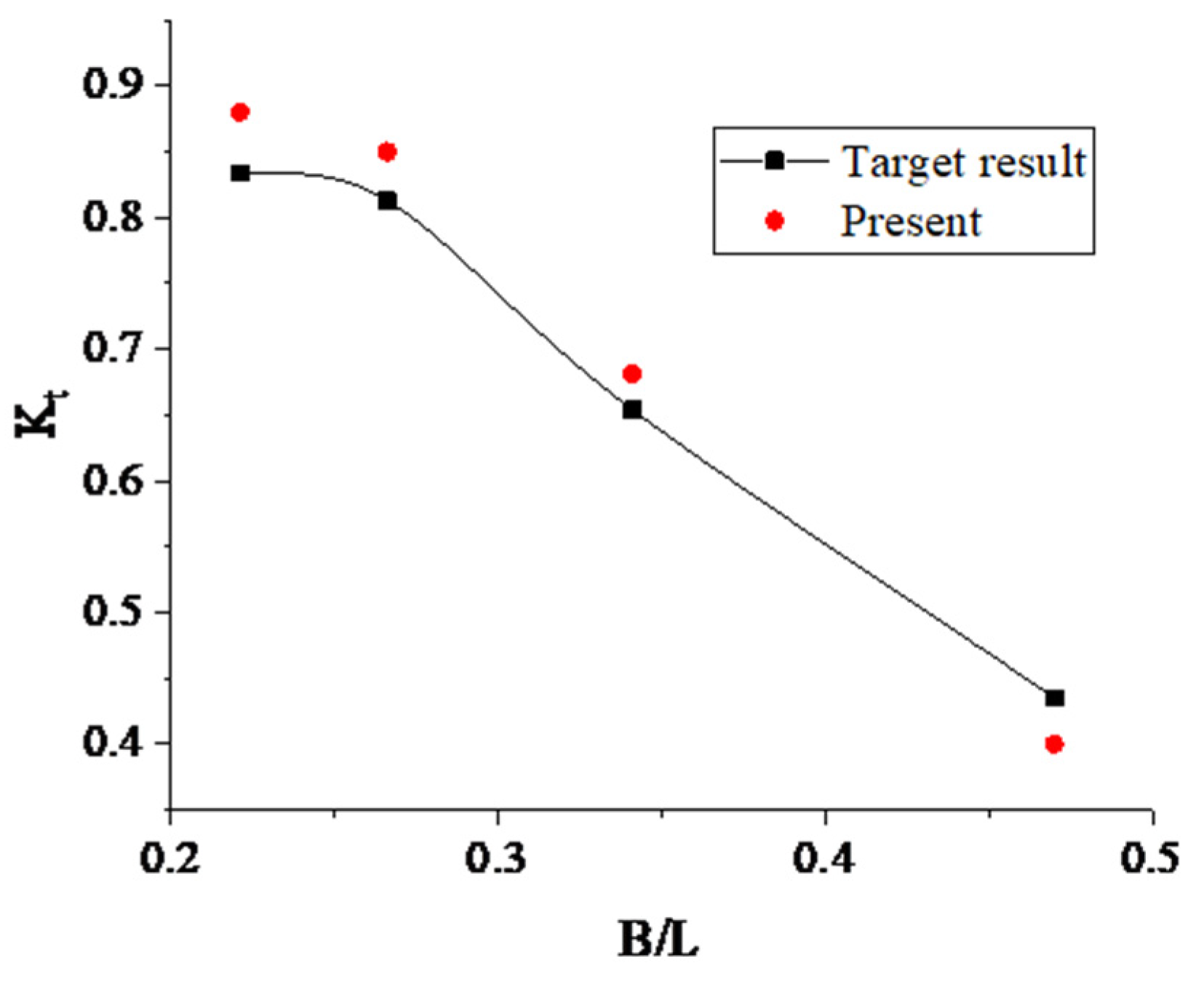
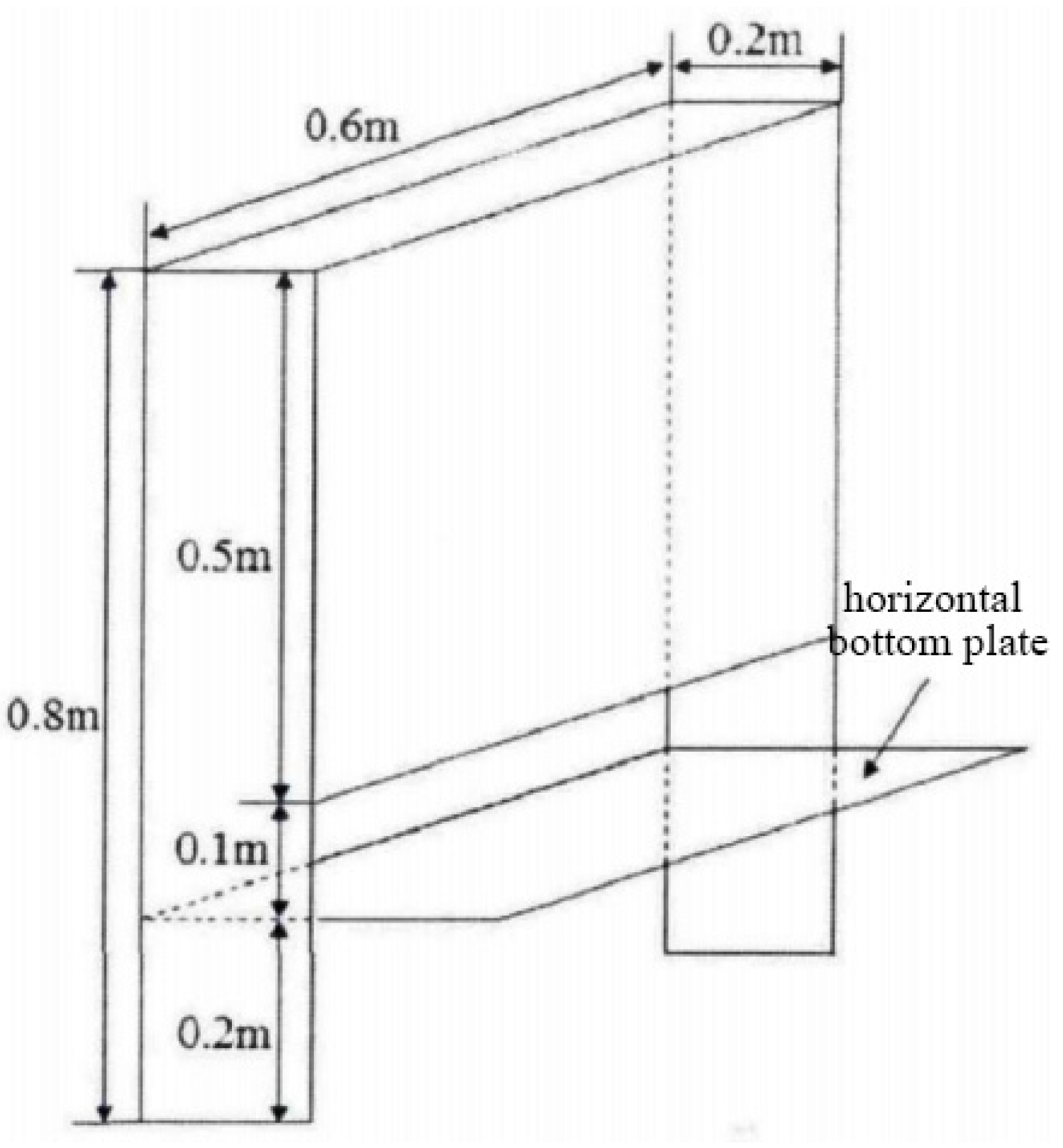
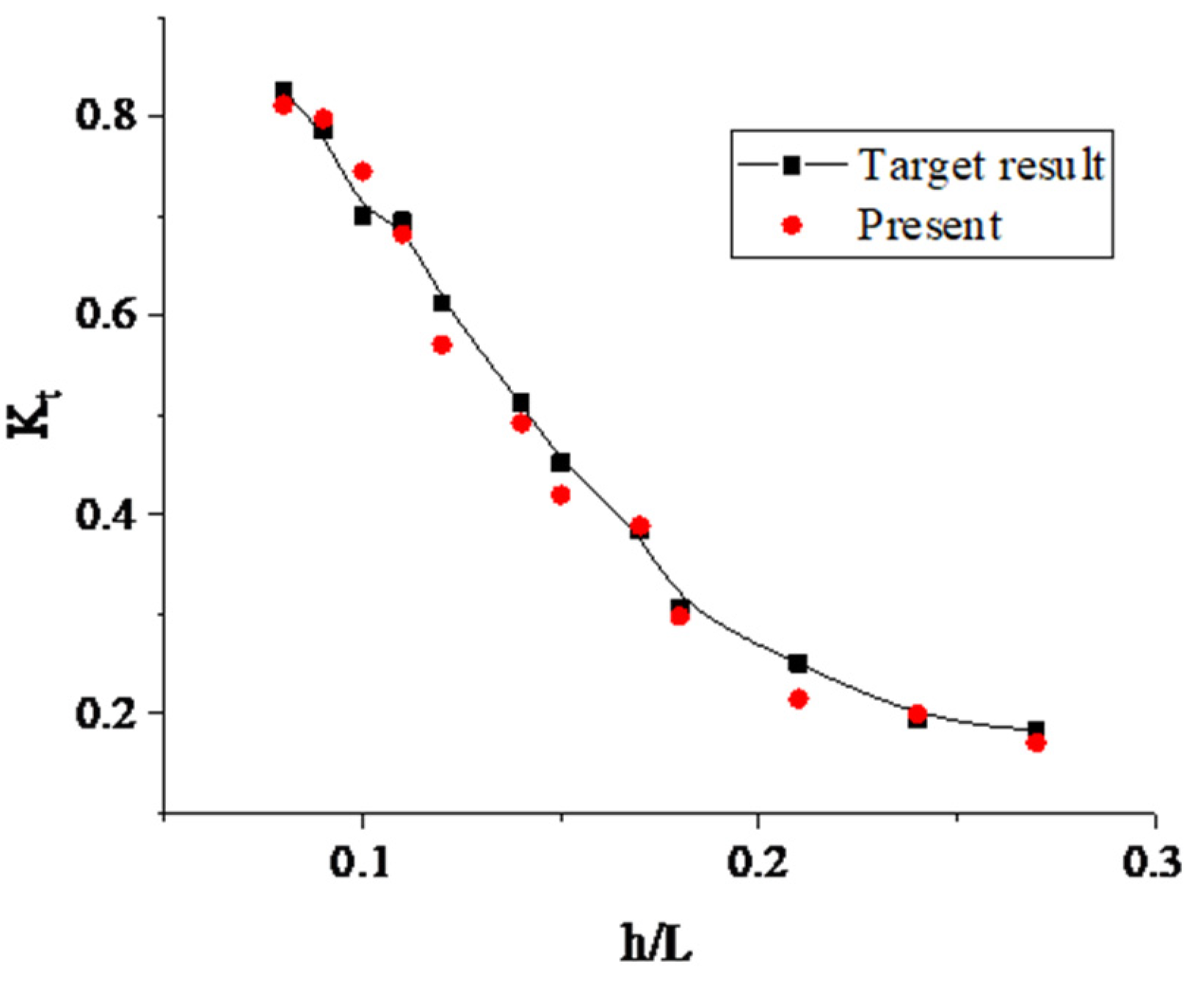
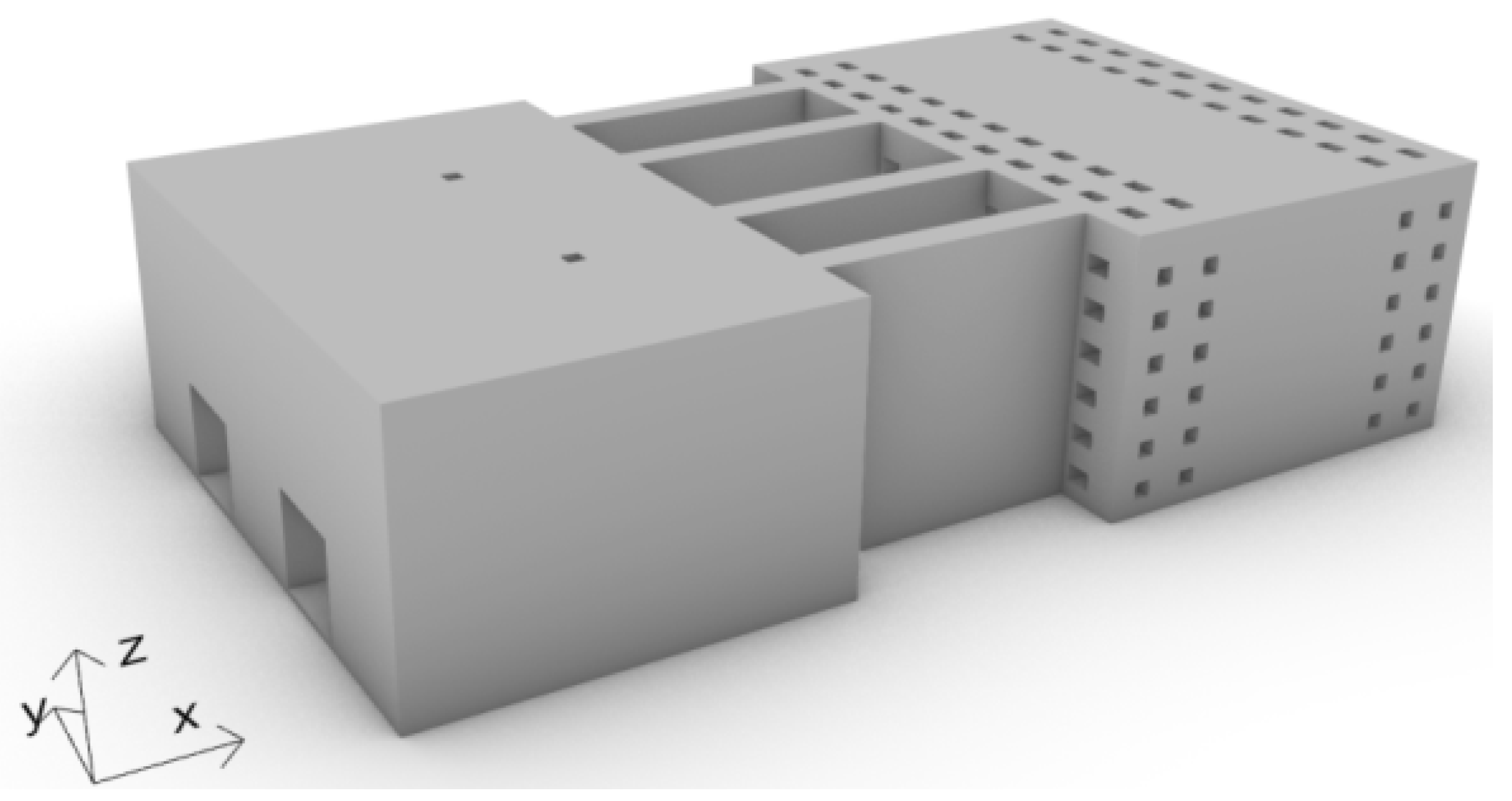


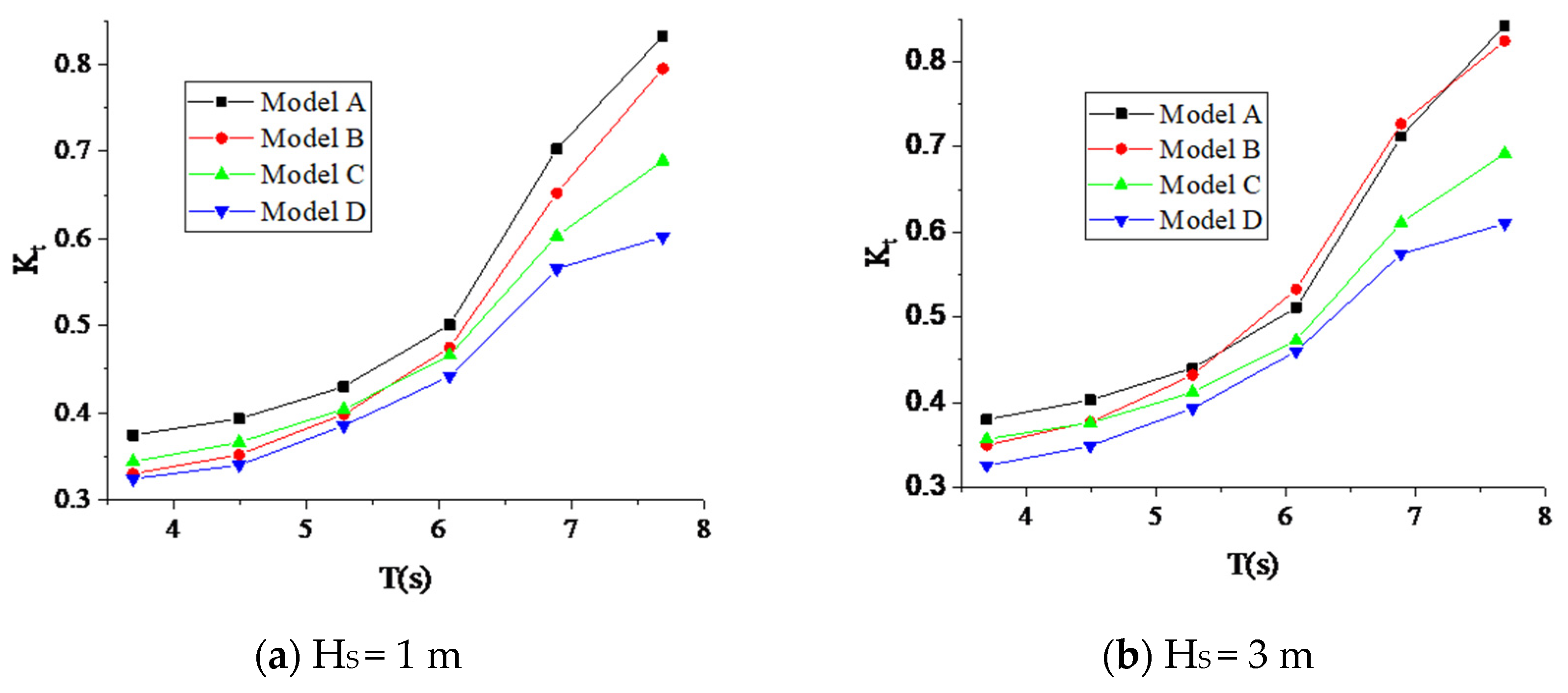
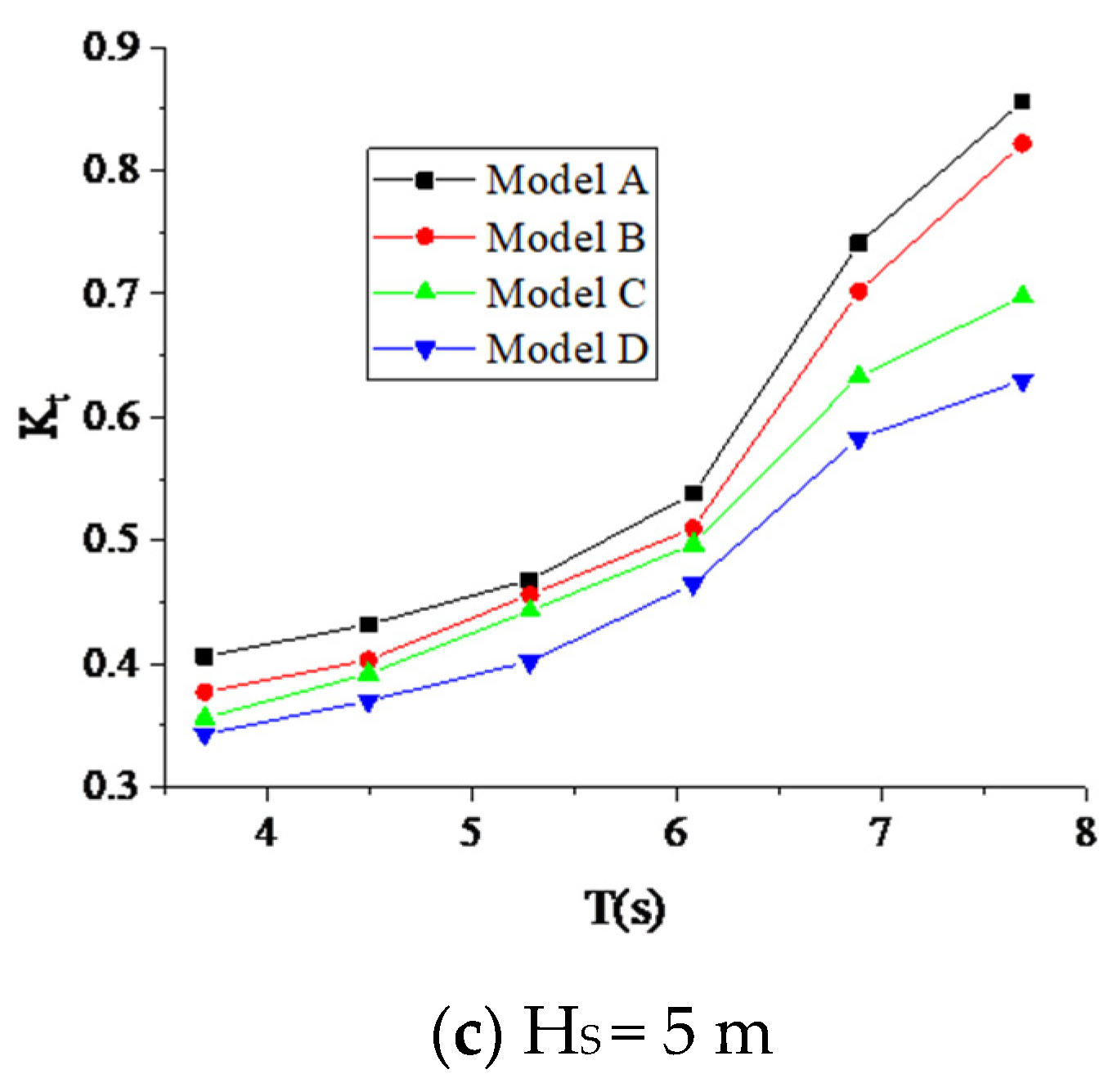
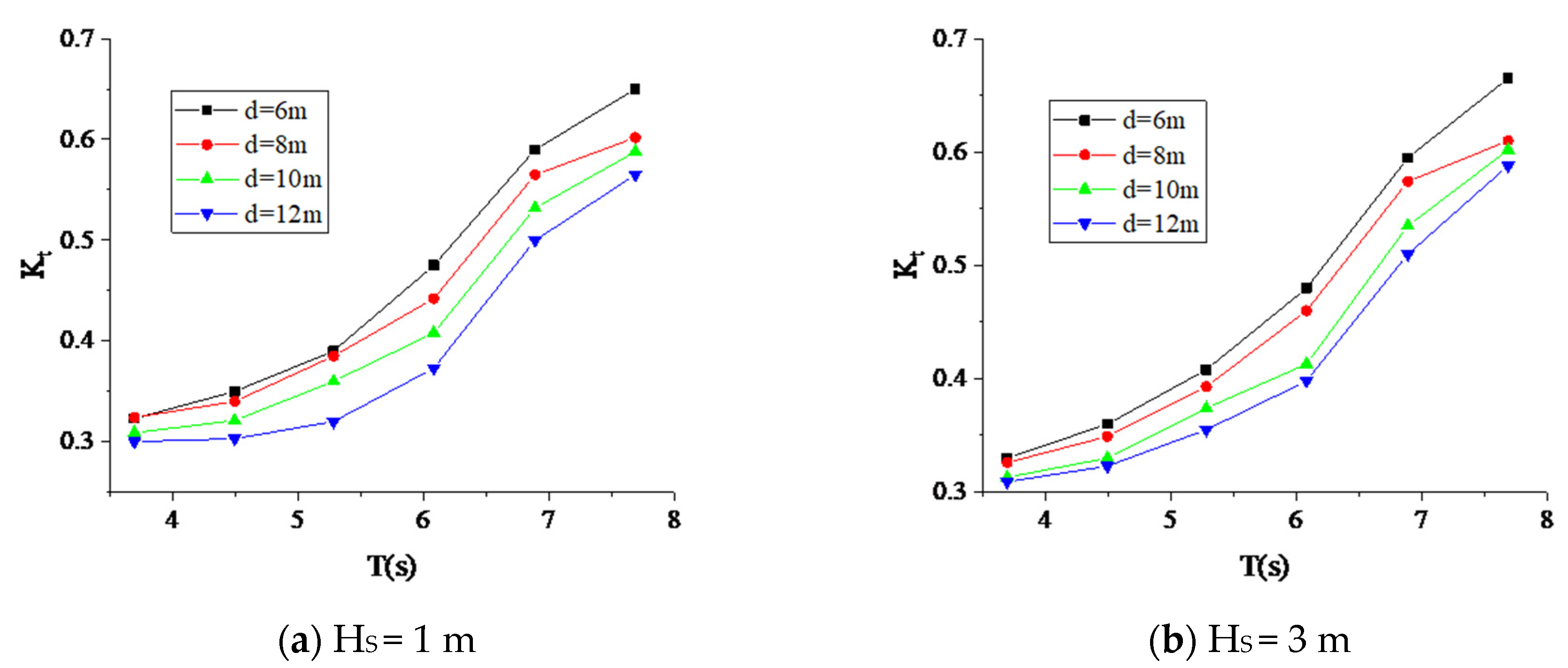
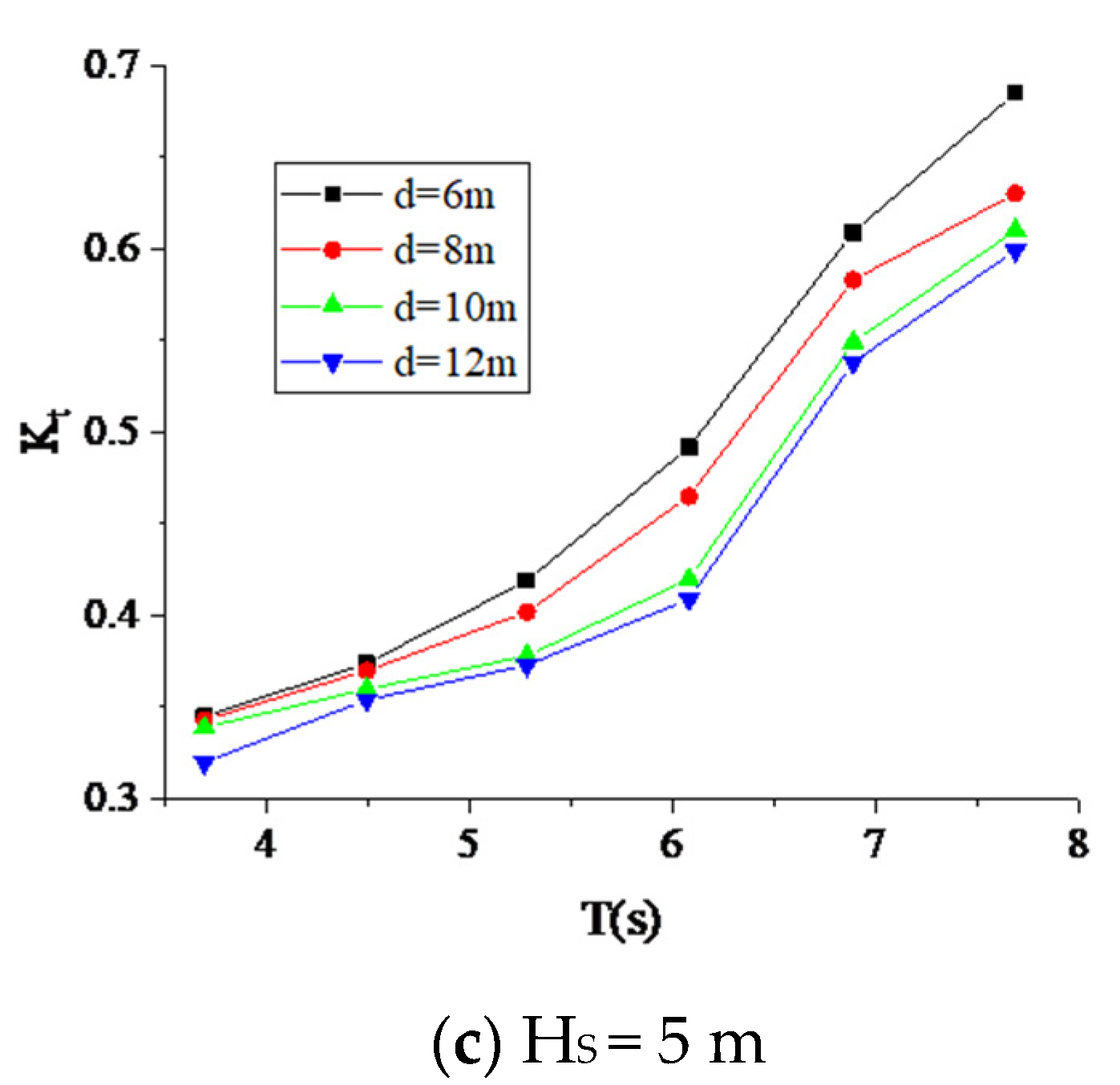
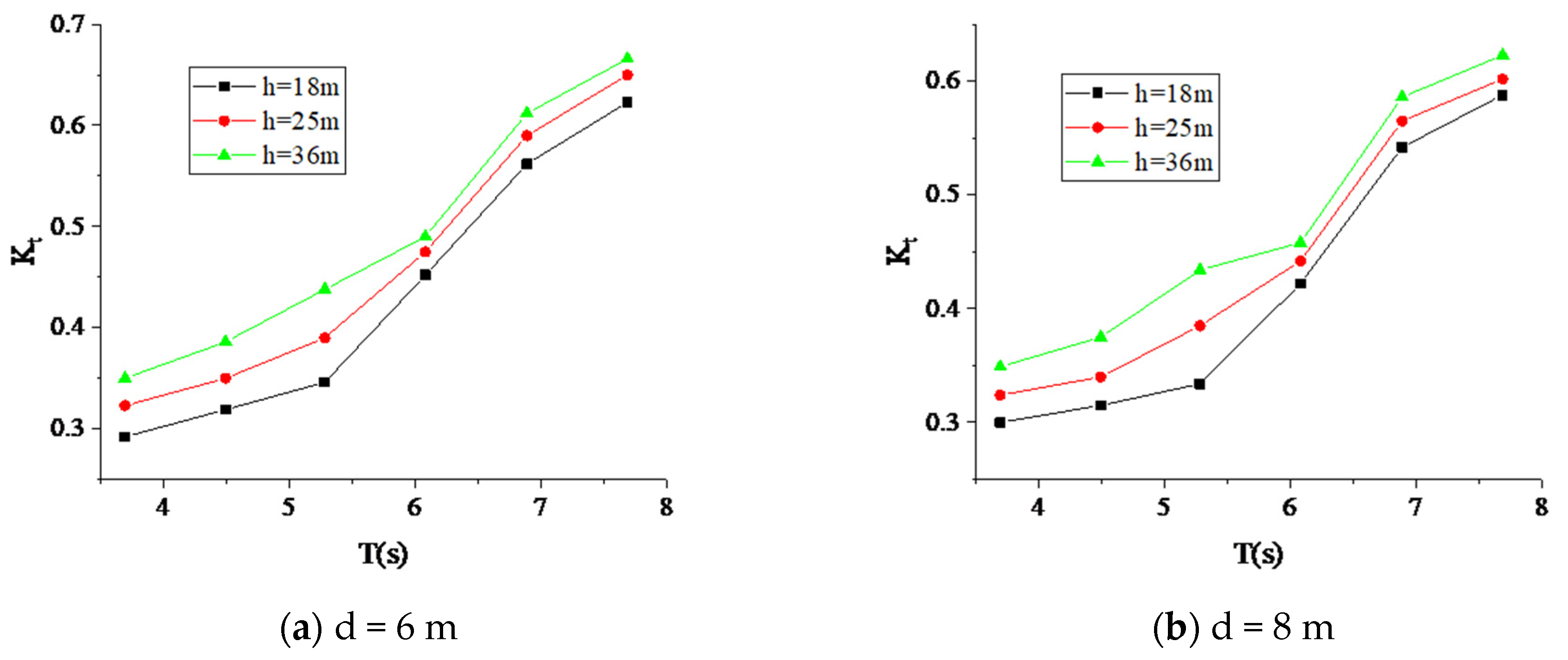
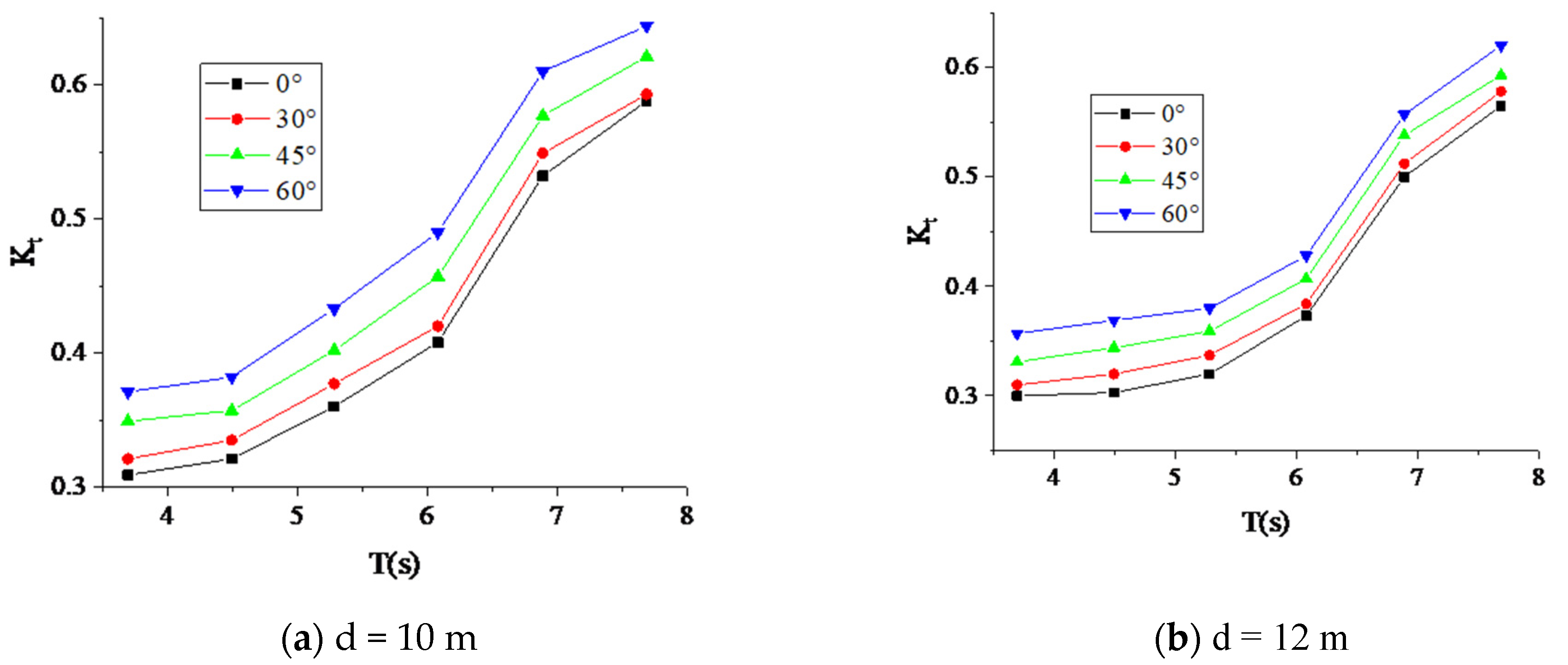
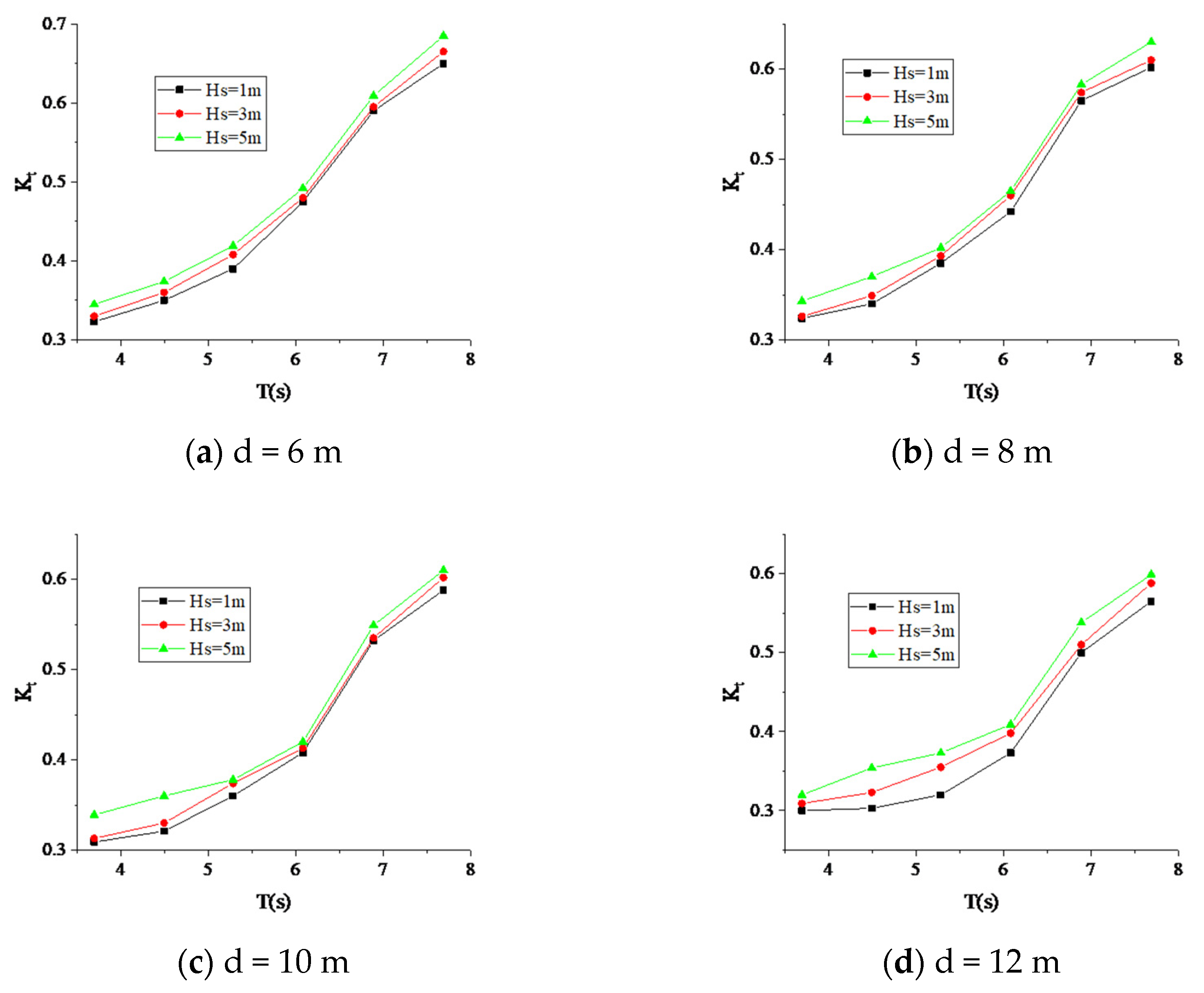
| W/L | Target Result | Present | Error | Average Error |
|---|---|---|---|---|
| 0.11 | 0.990 | 0.995 | 0.52% | 1.69% |
| 0.12 | 0.983 | 0.986 | 0.35% | |
| 0.14 | 0.937 | 0.928 | 0.87% | |
| 0.18 | 0.858 | 0.846 | 1.22% | |
| 0.24 | 0.643 | 0.678 | 3.50% | |
| 0.30 | 0.563 | 0.600 | 3.67% |
| W/L | Target Result | Present | Error | Average Error |
|---|---|---|---|---|
| 0.22 | 0.833 | 0.881 | 4.78% | 3.69% |
| 0.27 | 0.815 | 0.851 | 3.62% | |
| 0.34 | 0.654 | 0.683 | 2.89% | |
| 0.47 | 0.437 | 0.402 | 3.47% |
| W/L | Target Result | Present | Error | Average Error |
|---|---|---|---|---|
| 0.08 | 0.827 | 0.814 | 1.33% | 2.08% |
| 0.09 | 0.790 | 0.801 | 1.11% | |
| 0.10 | 0.704 | 0.748 | 4.42% | |
| 0.11 | 0.697 | 0.686 | 1.11% | |
| 0.12 | 0.616 | 0.571 | 4.42% | |
| 0.14 | 0.516 | 0.494 | 2.21% | |
| 0.15 | 0.457 | 0.424 | 3.31% | |
| 0.17 | 0.386 | 0.391 | 0.44% | |
| 0.18 | 0.311 | 0.300 | 1.11% | |
| 0.21 | 0.254 | 0.216 | 3.76% | |
| 0.24 | 0.197 | 0.203 | 0.66% | |
| 0.27 | 0.186 | 0.175 | 1.11% |
| Parameter | Symbol | Content |
|---|---|---|
| Water depth | h | 18 m, 25 m, 36 m |
| Significant wave height | HS | 1 m, 3 m, 5 m |
| Spacing | d | 6 m, 8 m, 10 m, 12 m |
| Period | T | 3.69 s, 4.49 s, 5.28 s, 6.08 s, 6.89 s, 7.69 s |
| Incident wave angle | θ | 0°, 30°, 45°, 60° |
| Model | Type | Sketch Map |
|---|---|---|
| Model A | dual-box |  |
| Model B | combination of OWC-box and standard box |  |
| Model C | combination of standard box and perforated box |  |
| Model D | combination of OWC-box and perforated box |  |
Disclaimer/Publisher’s Note: The statements, opinions and data contained in all publications are solely those of the individual author(s) and contributor(s) and not of MDPI and/or the editor(s). MDPI and/or the editor(s) disclaim responsibility for any injury to people or property resulting from any ideas, methods, instructions or products referred to in the content. |
© 2023 by the authors. Licensee MDPI, Basel, Switzerland. This article is an open access article distributed under the terms and conditions of the Creative Commons Attribution (CC BY) license (https://creativecommons.org/licenses/by/4.0/).
Share and Cite
Zheng, Y.; Li, J.; Mu, Y.; Zhang, Y.; Huang, S.; Shao, X. Numerical Study on Wave Dissipation Performance of OWC-Perforated Floating Breakwater under Irregular Waves. Sustainability 2023, 15, 11427. https://doi.org/10.3390/su151411427
Zheng Y, Li J, Mu Y, Zhang Y, Huang S, Shao X. Numerical Study on Wave Dissipation Performance of OWC-Perforated Floating Breakwater under Irregular Waves. Sustainability. 2023; 15(14):11427. https://doi.org/10.3390/su151411427
Chicago/Turabian StyleZheng, Yanna, Jiafan Li, Yingna Mu, Yu Zhang, Siyao Huang, and Xiran Shao. 2023. "Numerical Study on Wave Dissipation Performance of OWC-Perforated Floating Breakwater under Irregular Waves" Sustainability 15, no. 14: 11427. https://doi.org/10.3390/su151411427
APA StyleZheng, Y., Li, J., Mu, Y., Zhang, Y., Huang, S., & Shao, X. (2023). Numerical Study on Wave Dissipation Performance of OWC-Perforated Floating Breakwater under Irregular Waves. Sustainability, 15(14), 11427. https://doi.org/10.3390/su151411427




